Follow along for live updates on the submersible that vanished while taking five people down to the wreck of the Titanic.
US NAVY ACOUSTIC SYSTEM DETECTED 'ANOMALY' THAT WAS LIKELY IMPLOSION, OFFICIAL SAYS
A U.S. Navy acoustic system detected an 'anomaly' Sunday that was likely the Titan’s fatal implosion, according to a senior military official.
The Navy went back and analyzed its acoustic data after the Titan submersible was reported missing Sunday. Coast Guard officials on Thursday announced that the craft suffered a catastrophic implosion, killing all five aboard.
That anomaly was "consistent with an implosion or explosion in the general vicinity of where the TITAN submersible was operating when communications were lost," according to a senior Navy official.
The official spoke on condition of anonymity to discuss a sensitive acoustic detection system.
The Navy passed on the information to the Coast Guard, which continued its search because the Navy did not consider the data to be definitive.
The Wall Street Journal on Thursday first reported the Navy's involvement.
TITANIC SALVAGE RIGHTS OWNER MOURNS LOSS OF SHIPWRECK EXPERT
RMS Titanic, Inc., the company that owns the salvage rights to the Titanic shipwreck, is mourning the loss of Titanic expert Paul-Henri Nargeolet, who was among five people killed aboard the Titan submersible when it imploded this week.
Nargeolet — known as "PH" — was a long-term employee of the company, and his father was previously its CEO.
"The maritime world has lost an iconic and inspirational leader in deep-sea exploration, and we have lost a dear and treasured friend," the company said in a statement Thursday.
Friend and former colleague Matthew Tulloch said Nargeolet loved his work from the time they collaborated in the 1990s up until Nargeolet's death.
"I never got the impression that he was looking forward to retirement," Tulloch said with a small laugh. "You sort of think of people as they retire, then they can go on and do things that they love to do. This was exactly that for him — I can’t think of anything that I'm aware of that he would enjoy doing more than traveling around and sharing information and his experiences with people."
WHITE HOUSE OFFERS CONDOLENCES TO FAMILIES OF TITAN VICTIMS
The White House offered its condolences to the families mourning the five people killed aboard the Titan submersible.
U.S. Coast Guard officials announced their deaths Thursday following the vessel’s catastrophic implosion in the North Atlantic.
"Our hearts go out to the families and loved ones of those who lost their lives on the Titan," the White House said in a statement. "They have been through a harrowing ordeal over the past few days, and we are keeping them in our thoughts and prayers."
The statement also thanked the searchers, including the Coast Guard, involved in the international effort to find the submersible.
"This has been a testament to the skill and professionalism that the men and women who serve our nation continue to demonstrate every single day," the statement said.
'TITANIC' DIRECTOR JAMES CAMERON SAYS DEEP-SEA EXPLORERS VOICED CONCERNS ABOUT TITAN
"Titanic" movie director James Cameron says the Titan submersible tragedy has eerie parallels to the ocean liner's disaster more than a century ago.
Debris from the submersible's catastrophic implosion, killing all five aboard, was discovered near the shipwreck.
In an interview with ABC News, Cameron said he was "struck" by the similarities. The Titanic's captain ignored warnings about ice in the North Atlantic, and the movie director said deep-sea explorers voiced concerns about the Titan submersible, saying it was too experimental to carry passengers.
"To take place at the same exact site with all the diving that's going on all around the world, I think it's just astonishing," Cameron told the TV station. "It's really quite surreal."
Cameron had previously traveled to the Titanic wreckage, including on Sept. 11, 2001, in a submersible vessel.
PAKISTAN OFFERS CONDOLENCES TO FAMILY OF FATHER AND SON ABOARD IMPLODED SUBMERSIBLE
Pakistan has offered the country’s condolences to the Dawood family after the father-and-son explorers were among five killed when the Titan submersible imploded deep in the North Atlantic waters during a trip to the Titanic’s wreckage.
Pakistani nationals Shahzada Dawood and his son Suleman were aboard the Titan when it went missing Sunday. Authorities on Thursday said the catastrophic implosion meant there were no survivors.
The Dawoods are members of one of Pakistan’s most prominent families and their firm, Dawood Hercules Corp., based in Karachi, is involved in agriculture, petrochemicals and telecommunication infrastructure.
“Our deepest condolences to the Dawood family and the family of other passengers on the sad news about the fate of Titanic submersible in the North Atlantic,” Pakistan’s Foreign Ministry wrote on Twitter. “We appreciate the multinational efforts over the last several days in search of the vessel.”
COAST GUARD SAYS SOUNDS HEARD DURING SEARCH LIKELY UNRELATED TO TITAN SUBMERSIBLE
The Coast Guard says underwater sounds and banging noises detected in the search area for the Titan were likely unrelated to the missing submersible.
The sounds, heard over two days, gave hope to searchers and those watching the massive effort unfold since Sunday, when the vessel was reported missing, but ultimately seems irrelevant.
Experts say the ocean floor is a "noisy" place and a potential connection between the banging and the Titan were unlikely.
Debris from the Titan, which suffered a catastrophic implosion that killed all five men aboard, was found near the Titanic shipwreck deep in the North Atlantic waters.
"There doesn’t appear to be any connection between the noises and the location on the seafloor," Rear Adm. John Mauger of the First Coast Guard District said Thursday.
COAST GUARD WILL CONTINUE SEARCHING SEA FLOOR FOR CLUES
The Coast Guard will continue searching the sea floor near the Titanic shipwreck for more clues about what happened to the Titan submersible deep in the North Atlantic waters.
Officials say there isn’t a timeframe for when they will call off the massive international search. Efforts to recover the submersible and the remains of the five men who died in a catastrophic implosion aboard the vessel remain ongoing.
Much of the search is being done by remotely operated underwater vehicles known as ROVs that can scan the sea floor.
"This is an incredibly unforgiving environment down there on the seafloor," Rear Adm. John Mauger of the First Coast Guard District said Thursday.
TITAN’S DEBRIS FIELD WAS FOUND NEAR TITANIC SHIPWRECK, COAST GUARD SAYS
Coast Guard officials say the Titan’s debris field was discovered near the Titanic shipwreck but it’s too early to tell exactly when the catastrophic implosion occurred.
The Titan submersible was reported missing Sunday – eight hours after it initially lost contact with its surface ship – and its 96-hour oxygen supply would have run out Thursday morning.
It’s not clear whether the implosion occurred Sunday or in the days following, during an international search effort to find the missing submersible.
The Titan’s debris field was located roughly 1,600 feet (488 meters) from the Titanic.
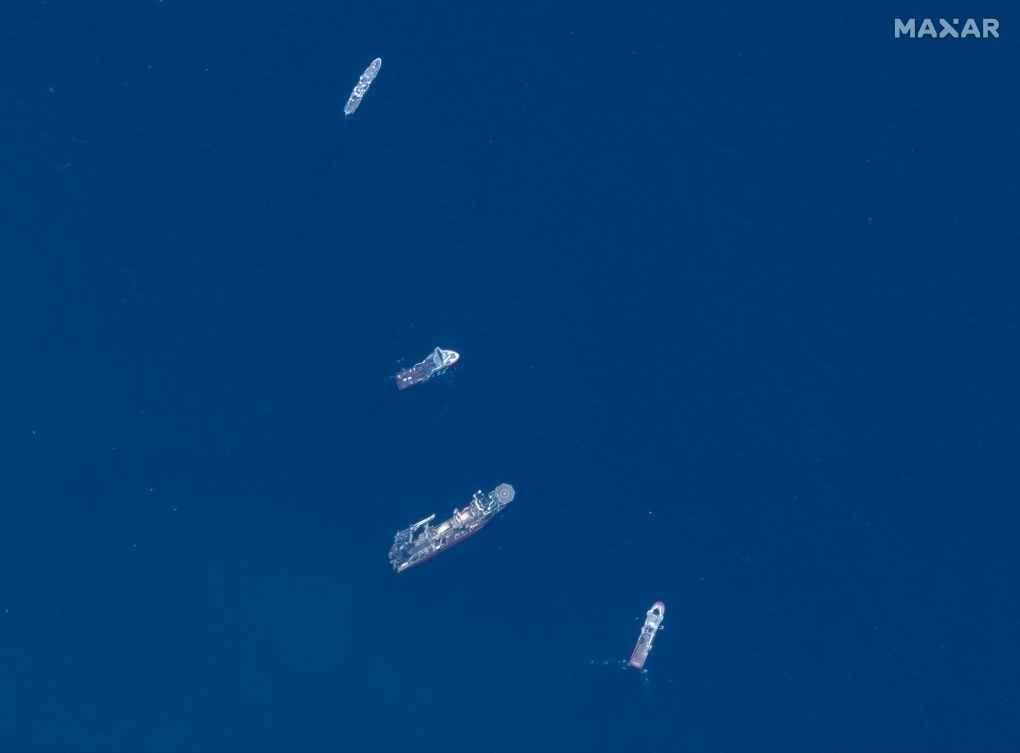 In this satellite image provided by Maxar Technologies, from top to bottom, the vessels L'Atalante, Horizon Arctic, Deep Energy, and Skandi Vinland search for the missing submersible Titan, Wednesday June 22, 2023 in the Atlantic Ocean. (Satellite image ©2023 Maxar Technologies via AP)
In this satellite image provided by Maxar Technologies, from top to bottom, the vessels L'Atalante, Horizon Arctic, Deep Energy, and Skandi Vinland search for the missing submersible Titan, Wednesday June 22, 2023 in the Atlantic Ocean. (Satellite image ©2023 Maxar Technologies via AP)
TITAN SUBMERSIBLE LIKELY IMPLODED AND THERE WERE NO SURVIVORS, COAST GUARD SAYS
The Coast Guard says the Titan submersible likely imploded in the North Atlantic waters and there were no survivors among the five people aboard.
The implosion likely occurred near the Titanic shipwreck, where the submersible was headed.
"The debris is consistent with the catastrophic loss of the pressure chamber," Rear Adm. John Mauger, the First Coast Guard District, said Thursday. "Our most heartfelt condolences go out to the loved ones of the crew."
OCEANGATE SAYS FIVE PEOPLE ON MISSING SUBMERSIBLE BELIEVED TO BE DEAD
The company leading the Titan submersible trip to the wreckage of the Titanic says the five missing crew members are believed to be dead.
OceanGate Expeditions on Thursday says its pilot and chief executive Stockton Rush, along with passengers Shahzada Dawood and his son Suleman Dawood, Hamish Harding, and Paul-Henri Nargeolet “have sadly been lost.”
OceanGate did not provide details Thursday when the company announced the “loss of life” in a statement or how officials knew the crew members perished.
The vessel’s 96-hour oxygen supply likely ended early Thursday morning.
The company has been chronicling the Titanic’s decay and the underwater ecosystem around it via yearly voyages since 2021.
 Composite photo of Titan passengers. From left: OceanGate CEO Stockton Rush; British billionaire Hamish Harding; Pakistani businessman Shahzada Dawood and his son, Suleman; and French explorer Paul-Henri Nargeolet.
Composite photo of Titan passengers. From left: OceanGate CEO Stockton Rush; British billionaire Hamish Harding; Pakistani businessman Shahzada Dawood and his son, Suleman; and French explorer Paul-Henri Nargeolet.
8-HOUR TIME DELAY TO REPORT MISSING TITAN RAISES QUESTIONS
Questions remain about the eight hours between when the Titan lost communication with the surface and when its Canadian support vessel reported it missing to the U.S. Coast Guard.
The time delay has yet to be explained by the company that owns the submersible, OceanGate Expeditions.
Sean Leet, head of the company that co-owns the Titan’s support ship, has refused to discuss the timeline, saying only that “all protocols were followed for the mission.”
But experts familiar with deep-sea exploration say those lost hours raise red flags.
The submersible used a rudimentary system that basically communicated with the surface ship through text message, and likely lacked an emergency radio beacon that could have floated to the surface and started beeping if there was an emergency.
The vessel had lost communication with the support ship, Canadian research icebreaker Polar Prince, during previous dives.
PAST DEEP-SEA RESCUES SHOW CHALLENGES FOR TITAN
The search for the Titan submersible has drawn attention to other deep-sea rescues, only some of which ended in lives being saved.
Those successful efforts -- from a submersible off Ireland to a submarine off the New Hampshire coast -- offer some measure of hope for the passengers and their families.
But many ended with some, if not all, the passengers on board dying -- demonstrating the inherent risk of operating in the deep ocean.
Either way, those rescue missions were not as complex as the effort to find the Titan submersible. They were often in shallower waters and, in several cases, were much bigger crafts.
For example, the USS Squalus sank off the coast of New England in 1939 during a test dive, due to a catastrophic valve failure that partially flooded the military submarine. A newly developed rescue chamber was lowered into the water to famously save the surviving 33 crew members. Twenty-six others drowned in the initial accident.
But the Titan is a civilian vessel and would not have standard Navy hatches that could attach to a rescue chamber like the one used for the Squalus. That makes it almost impossible to rescue any of the submersible's occupants if they are found underwater.
SEARCH FOR TITAN SHOWS NEED FOR MORE DEEP-SEA TECH
An underwater researcher says the search for the Titan shows the desperate need for more deep-sea technology in the U.S.
The unsuccessful efforts have "really opened up people's eyes that we need a much more robust capability over larger areas of the ocean to be able to detect and sense where things are," said Nick Rotker, who leads underwater research for non-profit research and development company MITRE.
The U.S. needs more underwater robots and remotely operated underwater vehicles, known as ROVs, to ensure safety, he said, especially as private exploration of the ocean expands.
"The issue is we don't have a lot of capability or systems that can go to the depth this vessel was going to," Rotker said.
Several ROVs are in the North Atlantic waters to search for the missing submersible. One found a debris field near the Titanic wreckage that could be linked to the Titan. The debris field was discovered by a robot from a Canadian vessel.
DEBRIS FIELD DISCOVERED BY DEEP-SEA ROBOT
Officials say a remote-operated robot discovered the debris field near the Titanic that could be linked to the missing Titan.
The robot is one of several remotely operated vehicles, known as ROVs, scanning the sea floor for clues of the missing submersible.
The ROVs are outfitted with cameras and travel to depths many other vessels cannot and have been used for undersea exploration for decades.
The Coast Guard's post on Twitter gave no details, such as whether officials believe the debris field is connected to the Titan.
The Titanic wreckage is located at a depth of 12,500 feet (3.8 kilometers) in the North Atlantic waters.
The Coast Guard has scheduled an afternoon news conference in Boston to discuss the ROV's findings.
DEBRIS FIELD DISCOVERED
The U.S. Coast Guard says an underwater vessel has located a debris field near the Titanic in the search for a missing submersible with five people aboard, a potential breakthrough in an increasingly urgent around-the-clock effort.
The Coast Guard's post on Twitter gave no details, such as whether officials believe the debris is connected to the Titan, which was on an expedition to view the wreckage of the Titanic. The search passed the critical 96-hour mark Thursday morning when breathable air could have run out.
The Titan was estimated to have about a four-day supply of breathable air when it launched Sunday morning in the North Atlantic -- but experts have emphasized that was an imprecise approximation to begin with and could be extended if passengers have taken measures to conserve breathable air.
PAKISTAN'S GOV'T FOLLOWING SEARCH FOR TITAN AND 2 NATIONALS ABOARD
A spokesperson for Pakistan's Foreign Ministry says the country's diplomats in the United States and Canada are following developments in the search for the Titan.
Pakistani businessman Shahzada Dawood and his son, Suleman, are among the five people aboard the submersible that went missing Sunday as it descended to the wreckage of the Titanic. Ministry spokesperson Mumtaz Zahra Baloch said Thursday in Islamabad that the government has confidence the search mission will be pursued effectively.
It was the first comment by any Pakistani official since the submersible vanished. The Dawoods are members of one of the country's most prominent families.
AS OXYGEN LEVELS RUN LOW ON BOARD TITAN, PASSENGERS CAN MAKE MINOR CONSERVATION EFFORTS
The Titan was said to have enough oxygen on board to to last 96 hours, according to the U.S. Coast Guard, meaning they could run out sometime Thursday.
But there are ways the five passengers can conserve, said professor Hugh Montgomery, director of the Centre for Human Health and Performance at University College London, even as temperatures drop to near freezing.
The human body makes every effort to maintain a core body temperature so shivering may increase oxygen demands, he said.
"The only effective way to limit O2 demand in this circumstance is not to burn excess energy," Montgomery said.
That means staying immobile or sleeping. Meditation can also slightly reduce oxygen demand by producing less stress hormones, less movement and more relaxed muscles, but such effects will be marginal, he said.
FRENCH DEEP SEA ROBOT JOINS INTERNATIONAL SEARCH FOR MISSING SUBMERSIBLE
A French deep sea robot that can dive to depths of 6,000 meters (19,685 feet) has joined the search for the missing Titan submersible and its five passengers.
France's state-run ocean research institute said Thursday the Victor 6000 is fitted with cameras, lights and robotic arms that could, if Titan is found, assist in raising it to the surface.
"With all of its cameras and things, we're capable of finding things really well in an area 20 to 30 meters (yards) around," said Olivier Lefort, the fleet director at the French ocean research institute Ifremer. He added that if the Titan is found, Victor 6000 could help attach cables to the submersible in an effort to raise it.
The robot was aboard the French ocean research ship L'Atalante, which was working in the Atlantic, 48 hours away, when the Titan vanished Sunday on its way to the Titanic wreckage, which is at about 3,800 meters (12,467 feet) deep.
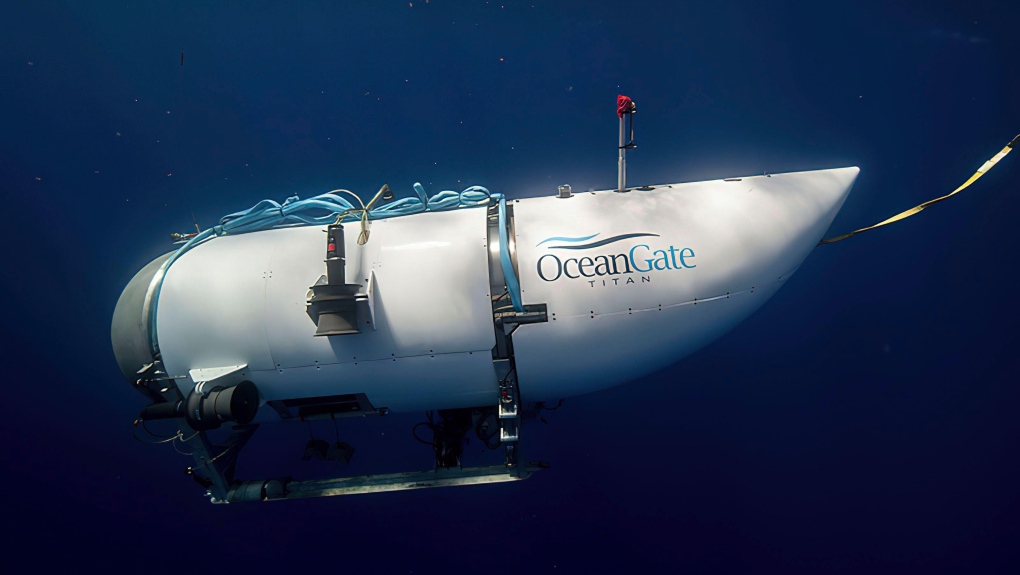 This photo provided by OceanGate Expeditions shows a submersible vessel named Titan used to visit the wreckage site of the Titanic. THE CANADIAN PRESS/AP-OceanGate Expeditions via AP
This photo provided by OceanGate Expeditions shows a submersible vessel named Titan used to visit the wreckage site of the Titanic. THE CANADIAN PRESS/AP-OceanGate Expeditions via AP
'DESPERATE SITUATION:' SCIENTISTS, WHILE REALISTIC ABOUT SURVIVAL CHANCES, OFFER HOPE
Scientists, while remaining realistic about the chances of finding the Titan on the vast ocean floor, are still offering a glimmer of hope.
Rob Larter, a marine geophysicist with the British Antarctic Survey, said in London on Thursday that it's incredibly difficult to find an object the size of the Titan in a totally dark environment. He says it's not going to be found with active sonar from a surface ship, but rather with a towed or autonomous vehicle that's near the seafloor. Even those vehicles can see just a matter of meters.
"I've been involved in searches for hydrothermal vent sites," he said. "We've have the vehicles just a few tens of meters away and missed them and then come back and find them. So it really is, you know, literally it's just a needle in a haystack situation unless you've got a pretty precise location"
Jamie Pringle, an expert in forensic geosciences at Keele University in the United Kingdom says the first 24 hours are critical in these kinds of rescue operations and that time period has long passed.
"So there's always a chance. It's never zero. But I think obviously the longer the time elapses, the lower the chance of success," he said.
Larter called it a "desperate situation" buy says you try to stay optimistic as long as possible.
"It's kind of unimaginable if people are alive, trapped in a submersible with oxygen supplies running down," he said.
THE SEARCH FOR THE SUBMERSIBLE IS NEARING THE CRITICAL 96-HOUR MARK
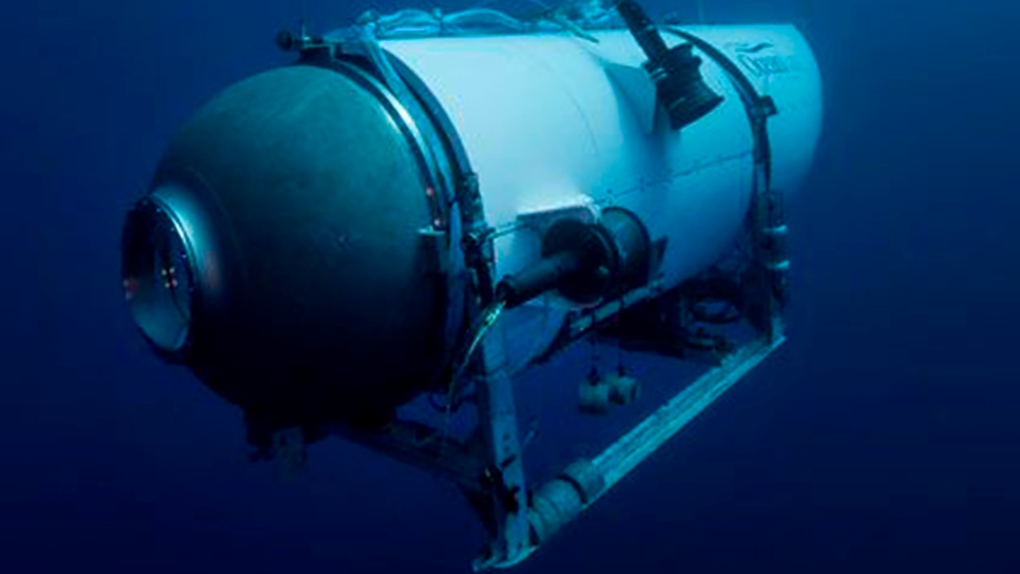 This undated image provided by OceanGate Expeditions in June 2021 shows the company's Titan submersible. (OceanGate Expeditions via AP, File)
This undated image provided by OceanGate Expeditions in June 2021 shows the company's Titan submersible. (OceanGate Expeditions via AP, File)
The search is nearing the critical 96-hour mark when breathable air is expected to run out, reaching a vital moment in the intense effort to save the five people aboard.
The Titan submersible was estimated to have a 96-hour supply of breathable air when it launched Sunday morning in the North Atlantic. That means the deadline to find and rescue the sub is roughly between 6 a.m. (1000 GMT) and 8 a.m. (1200 GMT) on Thursday based on estimates the U.S. Coast Guard and company behind the expedition have provided.
Experts say that the oxygen supply number is an imprecise estimate and could be extended if passengers have taken measures to conserve breathable air. And it's not known if they survived since the sub disappeared Sunday morning.
Officials have expanded the coverage area to thousands of miles -- twice the size of Connecticut and in waters 2 1/2 miles deep. Airplanes, ships, remote-operated underwater vehicles and a U.S. Navy-owned specialized salvage system have been deployed, concentrating where unidentified noises had been heard for two days. The noises raised hopes of a possible discovery.
TITAN SEARCHERS FACE UNDERWATER CHALLENGES TO FIND SUBMERSIBLE
Underwater mountains and valleys. Deep-sea water pressure. Weather conditions. And a search area twice the size of Connecticut -- in waters 2 1/2 miles (4 kilometers) deep -- with few clues about the Titan's location.
The crews tasked with finding the Titan, which was reported overdue Sunday night, are facing all those challenges and more to locate the submersible amid the North Atlantic waters.
While undersea search efforts are nothing new -- a 2019 expedition found two lost Japanese aircraft carriers that went down in World War II's historic Battle of Midway around the Northwestern Hawaiian Islands -- looking for the 22-foot-long (6.7-meter) carbon-fiber vessel amid the vast ocean is far more difficult than finding a needle in a haystack.
Those Japanese aircraft carriers were exponentially larger than the Titan -- and still they were lost for decades after the June 1942 air and sea battle.
"I've seen large vessels hiding within extreme geology so searching for smaller objects requires more detailed scrutiny as opposed to searching for a sunken (cruiser) or aircraft carrier," wrote Robert Kraft, a deep-sea explorer who was part of the 2019 expedition, in an email to The Associated Press from aboard his latest voyage.
SOUND MAY HELP, OR HINDER, SEARCH FOR MISSING SUBMERSIBLE
Teams racing to find the missing Titan submersible have detected underwater noises in the search area. But it won't be easy to find the source of that sound in the "noisy" ocean.
There are many other potential sources of sound underwater, including from fish, other animals and of course human-made instruments, according to Matt Dzieciuch, an ocean acoustics expert at the Scripps Institution of Oceanography.
While the Coast Guard said search teams heard banging noises at 30-minute intervals, it's still unclear whether the banging noises were a true signal of life.
Usually, an underwater vehicle will have a device called a pinger that can correspond with the surface and make it easier to locate, Dzieciuch said. But it's unclear whether the Titan submersible was using one.
The search team is facing additional challenges because sound gets bent as it travels underwater, due to how pressure and temperature change at different depths, Dzieciuch said. That can create echo-like effects and make it hard to locate the source of a particular sound.
TITAN FACED PROBLEMS DURING PREVIOUS VOYAGES
Since its first expedition to the Titanic shipwreck in the summer of 2021, the Titan's crews encountered problems aboard the submersible, including issues with its electrical system and battery, according to documents filed in a federal court in Virginia that oversees matters involving the Titanic shipwreck.
The issues during the first expedition were mostly electrical problems that were "solved as they came up," according to the documents filed by OceanGate Expeditions, the undersea exploration company that commanded the Titan's missions.
Ultimately, 18 of the submersible's crew members explored the wreck site for the first time in 2021, the filing stated. Others, such as Paul-Henry Nargeolet, had already traveled to the site.
Nargeolet co-piloted four dives in 2021 and is one of the five people missing since the submersible vanished Sunday on its latest dive to the Titanic wreck.
The 2022 expedition brought more problems to the Titan.
"On the first dive to the Titanic, the submersible encountered a battery issue and had to be manually attached to its lifting platform," the company wrote in another filing. "In the high sea state, the submersible sustained modest damage to its external components and OceanGate decided to cancel the second mission for "repairs and operational enhancements."
TITAN EXPEDITION FEATURED MULTIPLE MISSIONS TO SHIPWRECK
 A search for the missing submarine is being conducted in a remote part of the Atlantic Ocean about 1,450 kilometres off Cape Cod.
A search for the missing submarine is being conducted in a remote part of the Atlantic Ocean about 1,450 kilometres off Cape Cod.
The Titan's voyage this month was one of several missions the submersible took to the Titanic's wreck site in recent weeks.
The entire expedition began in early May in St. John's, Newfoundland in Canada and was expected to last until the end of June, according to documents filed in a federal court in Virginia that oversees matters involving the Titanic shipwreck.
Each mission lasted eight days, but it was not clear how many missions had taken place before the fateful trip -- or how many were scheduled to occur afterward. Eighteen total dives were planned.
An Instagram photo posted by OceanGate Expeditions, the undersea exploration company that commanded the Titan's missions, showed a group of smiling people labeled as "our Mission 3 and Mission 4 crew" at sea just days before the Titan vanished on Sunday -- the first day of its latest voyage.
UNDERSEA EXPLORATION ROBOTS CRITICAL IN SEARCH FOR MISSING SUBMERSIBLE
Remote-operated robots that are typically used for undersea exploration will instead be critical to any hope of finding the Titan.
There were two such remotely operated vehicles -- or ROVs -- in North Atlantic waters on Wednesday, with more on the way.
Designed to scan the sea floor in real time, the ROVs are outfitted with cameras and travel to depths many other vessels cannot.
ROVs have been used for undersea exploration since at least the mid-1980s, according to deep-sea explorer Katy Croff Bell, who is president of Ocean Discovery League.
The vessels are expensive to use and their method of data collection can be slow and painstaking, which is partly why scientists know so little about the ocean floor even after years of exploration.
But the ROVs might be the only way to find the Titan after the submersible vanished Sunday on a dive to the wreckage of the Titanic.
"ROVs are essential to the search and rescue mission," Bell said. "Really the only way you're going to be able to recover anything from the deep sea floor in real time."
SIMPLE VIDEO GAME CONTROLLER USED TO STEER TITAN
The Titan is steered by a simple, off-the-shelf video game controller -- to the shock of gamers worldwide.
It's not the only commercially available equipment onboard the submersible, according to OceanGate Expeditions' website.
"The use (of) off-the-shelf components helped to streamline the construction, and makes it simple to operate and replace parts in the field," the company said on its website.
The undersea exploration company, based in Everett, Washington, oversaw the Titan's mission and has been making yearly voyages to the Titanic since 2021.
OceanGate chief executive Stockton Rush, in an interview with the CBC last year, said the video game controller is "super durable." There are spare controllers kept onboard, but is not clear whether the submersible also had manual controls or other redundancies.
"It's meant for a 16 year old to throw it around," said Rush, who is the Titan's pilot and among the five people missing.
Documents show the company was repeatedly warned that there might be catastrophic safety problems posed by the way the submersible was developed.
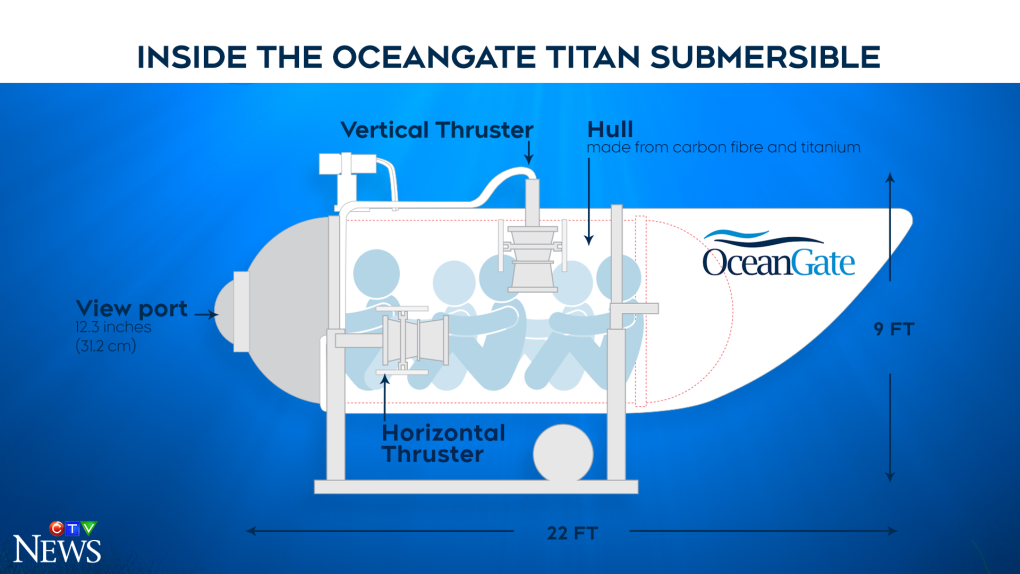 OceanGate's Titan submersible is made of carbon fibre and titanium. It weighs 9,525 kilograms and can reach a depth of up to 4,000 metres in the ocean. The submersible can also carry a payload weight of 685 kg and contains 96 hours of "life support" for a crew of five. (Graphic: Jasna Baric / CTVNews)
OceanGate's Titan submersible is made of carbon fibre and titanium. It weighs 9,525 kilograms and can reach a depth of up to 4,000 metres in the ocean. The submersible can also carry a payload weight of 685 kg and contains 96 hours of "life support" for a crew of five. (Graphic: Jasna Baric / CTVNews)
SPECIALIZED UNDERWATER VESSEL FLOWN FOR SEA FLOOR SEARCH
The daunting search and rescue effort for the Titan is rushing experts and specialized underwater equipment together by land, by air and by sea to find the submersible before its oxygen runs out.
A remotely operated vehicle that can scan the sea floor, known as an ROV, was flown to Canada on Tuesday and is expected to arrive at the Titanic site on Thursday morning.
"The equipment that is onsite and coming is the most sophisticated in the world and certainly capable of reaching those depths," said Sean Leet, chief executive of Canadian Horizon Maritime company.
The company and the Mi'kmaq band co-own the Polar Prince, which is the research vessel that launched the Titan.
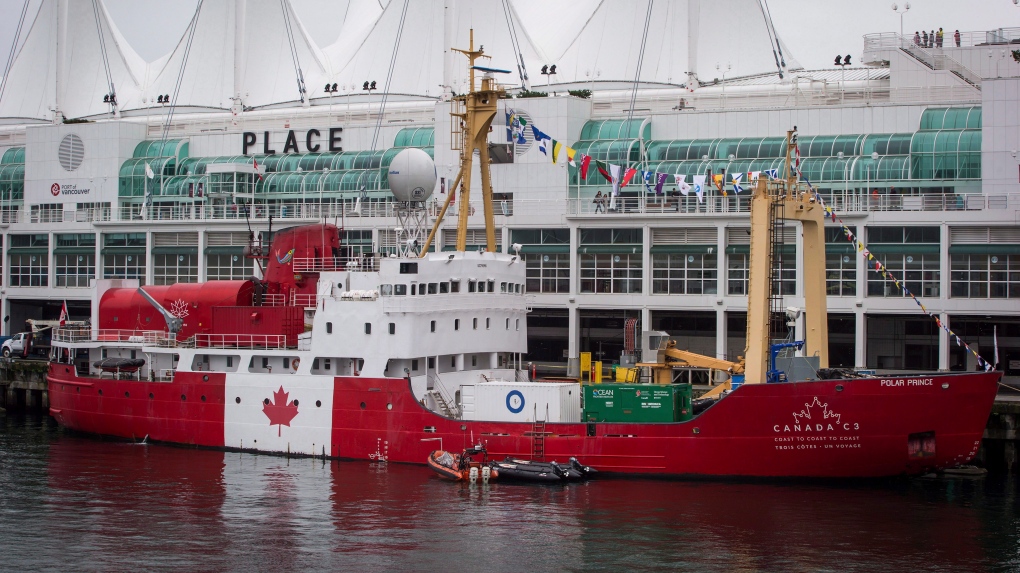 The Polar Prince ship is seen while moored in Vancouver, B.C., Oct. 23, 2017. OceanGate hired the Polar Prince to ferry dozens of people and the submersible craft to the North Atlantic wreck site. (Darryl Dyck/The Canadian Press via AP)
The Polar Prince ship is seen while moored in Vancouver, B.C., Oct. 23, 2017. OceanGate hired the Polar Prince to ferry dozens of people and the submersible craft to the North Atlantic wreck site. (Darryl Dyck/The Canadian Press via AP)
"We are praying for our friends onboard the Titan submersible," said Miawpukek First Nation Chief Mi'sel Joe. "We want them to come home safely. We ask everyone across Canada and the world to pray with us that we can find and rescue the Titan."
U.S. NAVY SENDING EQUIPMENT FOR POSSIBLE SALVAGE
The U.S. Navy is sending a specialized salvage system that's capable of hoisting "large, bulky and heavy undersea objects such as aircraft or small vessels" in the hopes that the Titan will be found in the waters of the North Atlantic.
The Titan weighs 20,000 pounds (more than 9,000 kilograms). The U.S. Navy's Flyaway Deep Ocean Salvage System is designed to lift up to 60,000 pounds (27,215 kilograms), the Navy said on its website.
The Flyaway has a traction winch as well as a system that prevents "high-snap tension" from occurring in the lift line.
PASSENGER ON 2021 DIVE TO TITANIC DESCRIBES RISKS
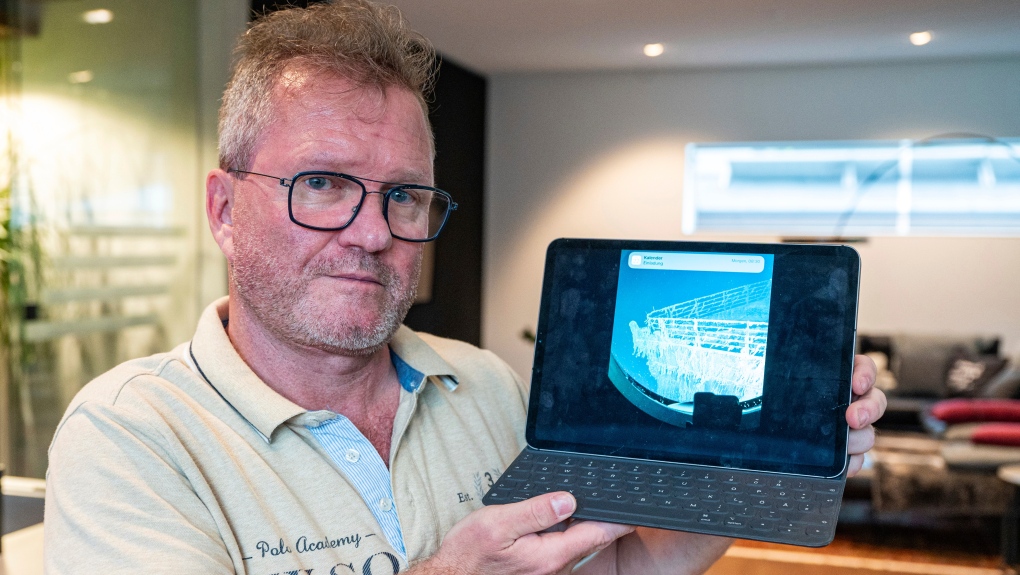 Arthur Loibl, one of the submersible company Oceangate's first customers, holds up a photo of the Titanic, in Straubing, Germany, June 21, 2023. (Armin Weigel/dpa via AP)
Arthur Loibl, one of the submersible company Oceangate's first customers, holds up a photo of the Titanic, in Straubing, Germany, June 21, 2023. (Armin Weigel/dpa via AP)
Looking back on his own 2021 dive to the Titanic, an early OceanGate passenger says one must be "a little bit crazy."
Arthur Loibl, a retired businessman and adventurer from Germany, told The Associated Press on Wednesday that he conceived the idea to see the Titanic while on a 2016 trip to the South Pole. He paid $110,000 for a dive in 2019, but the first submersible didn't survive testing. Loibl went two years later.
"Imagine a metal tube, a few meters long with a sheet of metal for a floor. You can't stand, you can't kneel. Everyone is sitting close to or on top of each other," Loibl said. "You can't be claustrophobic."
The dive, which was repeatedly delayed to fix problems, took 10 1/2 hours, he said.
Lost aboard the vessel are pilot Stockton Rush, the CEO of the company leading the expedition. His passengers are a British adventurer, two members of a Pakistani business family and a Titanic expert.
"I was a bit naive, looking back now," said Loibl.
COAST GUARD BRINGS IN MORE SHIPS FOR SEARCH
The Coast Guard says it is bringing in more ships and underwater vessels to search for a submersible missing in the North Atlantic after underwater sounds were detected, providing a glimmer of hope three days after the Titan disappeared while taking five people down to the wreck of the Titanic.
Although the exact location and source of the sounds were not yet determined, they allowed searchers to focus on a more narrowly defined area. The full scope of the search was twice the size of Connecticut and 2 1/2 miles (4 kilometers) deep, said Capt. Jamie Frederick of the First Coast Guard District.
"This is a search and rescue mission, 100%," Frederick said. "When you're in the middle of a search and rescue case, you always have hope."
But even those who expressed some optimism warned that many obstacles remain: from pinpointing the vessel's location, to reaching it with rescue equipment, to bringing it to the surface -- assuming it's still intact -- before the passengers' oxygen supply runs out.
The U.S. Coast Guard did not elaborate on what rescuers believe the noises could be. The vessel hasn't been heard from since Sunday. The passengers are estimated to have as little as a day's worth of oxygen left.














































